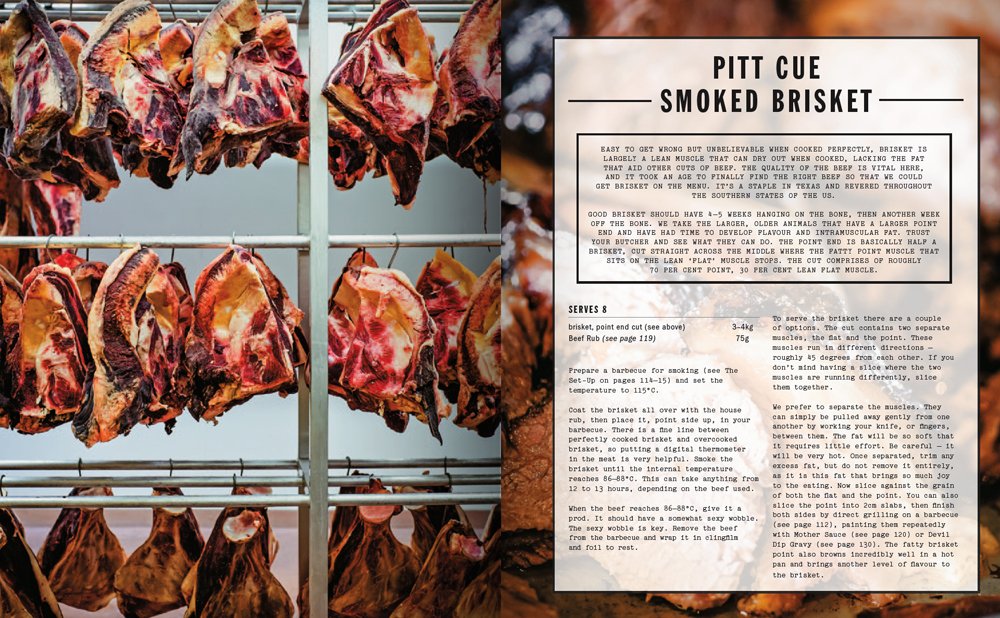This one is much more of a straight forward BBQ book - low-n-slow BBQ, where meat is smoked over a low heat for hours (upwards of 5, often 12+ hours).
I have mentioned elsewhere about the more fancy BBQ books, or the more story-telling BBQ books, but this one is a lot more straight forward - it starts with recipes about rubs, then meats (and the usual meats you'd expect - pulled pork, varieties of ribs, brisket, burgers etc), before going into normal sections for sides, drinks, deserts etc. It's an accessible read - and unlike the more fancy BBQ books, it has lots of recipes that you might turn to if you were having friends and family over. It does have the same issue (I'm reluctant to call it an issue - its more of a feature of the BBQ book genre - besides any specific rub recipe, its just one person's - or group of people - opinion on what works for them with regards timing and temperature.
Their brisket recipe, for example, is quite a bit more detailed than the Pitt Cue recipe of cook it until its about 86 degrees internal temperature and has a sexy wobble - they recommend coffee + olive oil with the rub, and have directions how to apply the rub, as well as recommending wrapping the meat after a few hours - but ultimately, cooking slowly is a lot more forgiving, so you can do what you like - if you want to wrap it, then go ahead, and honestly, the window to wrap it is pretty big (hours) so you don't need to worry about exact timings - basically try cooking a few times, if you find something that works, stick with it! That said, their burnt beetroots are something that I have since tried (and can recommend) - again not following the recipe as much as having never really thought about sticking beets straight into the coals, I did that, and it worked well!
It is another aesthetically pleasing book - the pictures are all really appetising and a good balance between rustic/dirty and delicious!
Overall, it's a fun BBQ book, thats good to read and a good coffee table book, that non BBQ fanatics can happily pick up and browse.
I have mentioned elsewhere about the more fancy BBQ books, or the more story-telling BBQ books, but this one is a lot more straight forward - it starts with recipes about rubs, then meats (and the usual meats you'd expect - pulled pork, varieties of ribs, brisket, burgers etc), before going into normal sections for sides, drinks, deserts etc. It's an accessible read - and unlike the more fancy BBQ books, it has lots of recipes that you might turn to if you were having friends and family over. It does have the same issue (I'm reluctant to call it an issue - its more of a feature of the BBQ book genre - besides any specific rub recipe, its just one person's - or group of people - opinion on what works for them with regards timing and temperature.
Their brisket recipe, for example, is quite a bit more detailed than the Pitt Cue recipe of cook it until its about 86 degrees internal temperature and has a sexy wobble - they recommend coffee + olive oil with the rub, and have directions how to apply the rub, as well as recommending wrapping the meat after a few hours - but ultimately, cooking slowly is a lot more forgiving, so you can do what you like - if you want to wrap it, then go ahead, and honestly, the window to wrap it is pretty big (hours) so you don't need to worry about exact timings - basically try cooking a few times, if you find something that works, stick with it! That said, their burnt beetroots are something that I have since tried (and can recommend) - again not following the recipe as much as having never really thought about sticking beets straight into the coals, I did that, and it worked well!
It is another aesthetically pleasing book - the pictures are all really appetising and a good balance between rustic/dirty and delicious!
Overall, it's a fun BBQ book, thats good to read and a good coffee table book, that non BBQ fanatics can happily pick up and browse.





